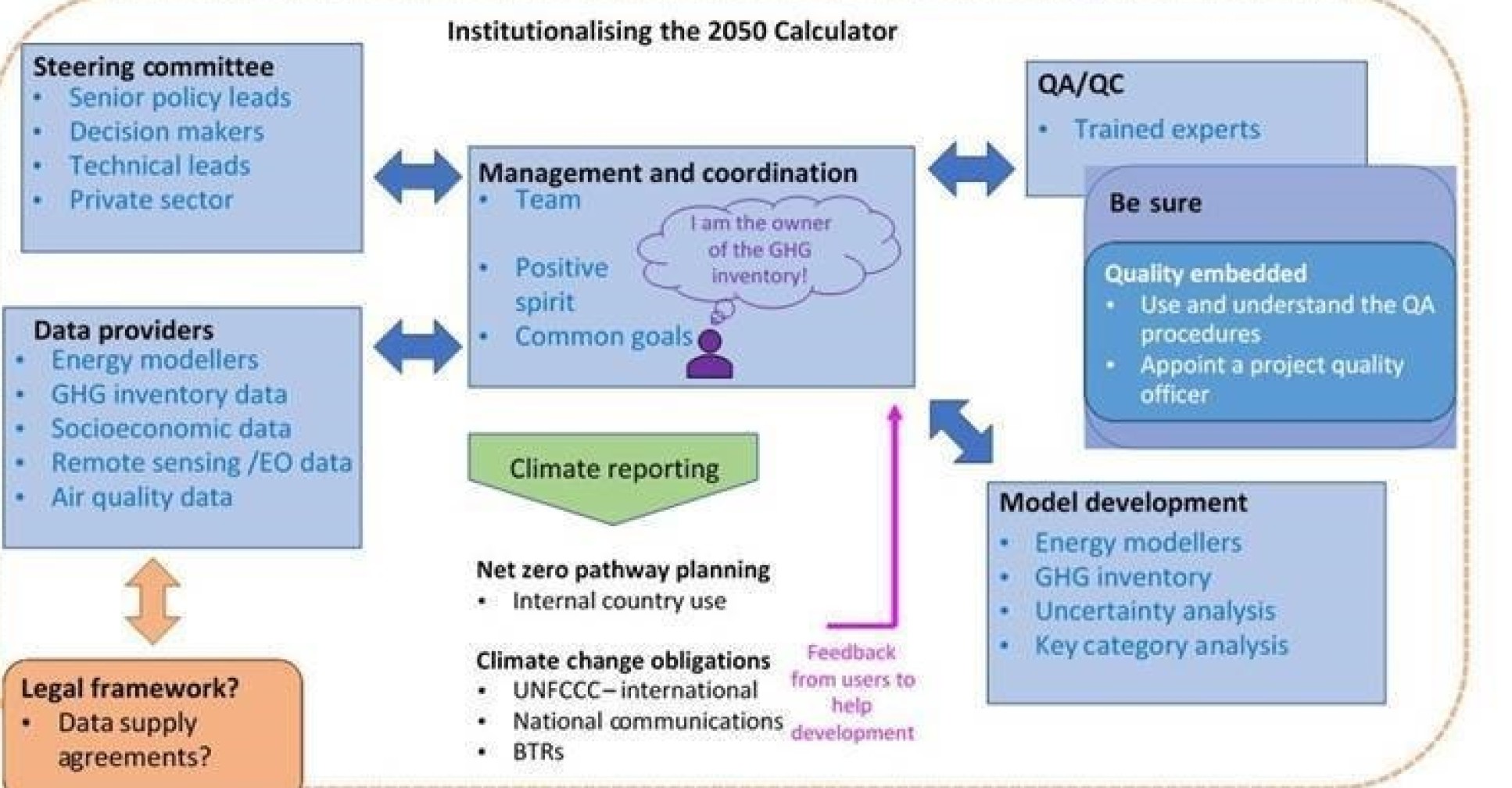

John Watterson (GGEI Knowledge Leader, Ricardo) explains why the institutionalisation of the 2050 Calculator is so important.
Why’s the institutionalisation of the 2050 Calculator so important? You’ve developed a Calculator; it works quite well; it’s helped you to understand your future energy pathways, and shown you how a net zero pathway might be achievable. Isn’t that enough?
To provide an answer on the importance of institutionalisation, we need to first ask a couple of questions – how can all the effort that has been invested to develop and promote your 2050 Calculator be maximised? How can the investment have an enduring effect?
One of the most effective ways of maximising investment is to ‘institutionalise’ the knowledge and insights gained during the work to develop the Calculator. ‘Institutionalisation’ is a word that is frequently used in capacity building, but what exactly does it mean? Simply put, it is the action of establishing something as a convention or norm in an organisation or culture. Thinking about it slightly differently in the context of the Calculator programme, the essence of institutionalisation is about embedding the Calculator in a country’s greenhouse gas mitigation planning, and placing the Calculator at the heart of the development of pathways to net zero.
To highlight how important institutionalisation of the Calculator should be, we looked back at the lessons of the past that helped shape the current 2050 Calculator programme. One of the ‘big 5’ lessons of flawed projects is that they fail when core people leave the project team. Institutionalisation is the key to help prevent failure when individuals leave a project, and will help preserve the memory of the Calculator for the future.
How exactly should you institutionalise your Calculator? Below are our thoughts summarised in a diagram:

Every country is likely to have an implementation that suits its unique circumstances, but with some common features, such as quality assurance/control. Note that any legal frameworks should encompass the whole Calculator system to ensure compliance, otherwise only the data supply agreements have a legal basis.
How should it be done? Who should be involved?
Institutional arrangements should build on existing national arrangements, where possible, or they can be restructured to promote effectiveness. The Calculator should have an institutional ‘home’ – a ministry, department or agency that is responsible for it – and it should also have an ‘owner’. Your country most likely already has a ministry/department/agency that is leading on climate issues. Could this be the Calculator’s home? The owner should be an individual, rather than a team, and they should have overall responsibility for the Calculator, including knowledge of who built it and where records describing how it works are kept. If the owner leaves the programme, the Calculator should be handed over to a new owner. The institutional arrangements should ensure that all the data for the current and future Calculators are understood, recorded, made available and backed up. The owner should facilitate important data flows and make sure skilled resources are available to work with stakeholders. Some countries find a legal framework works to make the use of the Calculator mandatory and to secure the data needed through data supply agreements.
How should it be promoted?
The owner and ministry/department/agency should promote the Calculator. Understanding and communicating the objectives of the institutional arrangements and clearly presenting the related organisational structures is critical. The owner should facilitate the use of the Calculator, ensuring it’s recognised at all levels of government and is embedded in all policy thinking, not just in policies related to climate change.
How long might it take?
Less time than you might think. If you’ve already developed a Calculator, you’ll need to implement two key additional aspects – to document the systems and procedures required and maintain them. Make it easy for the next Calculator generation to continue the good work.
Are there other co-benefits?
Yes, there are other important co-benefits to institutionalising your Calculator. Thinking of the climate reporting obligations that all countries have under the UNFCCC, the Calculator is likely to support your efforts to develop and enhance your measurement, reporting and verification and transparency system of climate action and support. It provides clear evidence that your country is making ambitious plans to tackle climate change, and the work it supports can be presented in your enhanced transparency report. As well as providing insight into greenhouse gas emissions, the Calculator can help in understanding the sources of air quality emissions and help to mitigate them.
Can you get help for institutionalising your 2050 Calculator?
Yes, you can. The UK-funded 2050 Calculator programme not only supports creation of country Calculators, but also aims to provide ongoing support to existing Calculator teams – including support for institutionalising Calculators.
So go ahead and institutionalise your 2050 Calculator. Create a plan, stick to it and check progress. What are the downsides to institutionalisation? We believe there are none.
Find out more
For further support on institutionalising Calculators, see the UNFCCC handbook on ‘institutional arrangements to support MRV/transparency of climate action and support’.
Author: John Watterson, Greenhouse Gas Emissions Inventories Knowledge Leader, Ricardo, March 2021
Article text (excluding photos or graphics) © Imperial College London.
Photos and graphics subject to third party copyright used with permission or © Imperial College London.
Reporter
Maria Barletta
Centre for Environmental Policy

Contact details
Email: press.office@imperial.ac.uk
Show all stories by this author



